Interface Electronics06 DAC Architectures and ErrorProf. Dr. Jörg Vollrath05 DAC Architectures |
Video Lecture: DAC errors
|
Länge: 01:06:27 |
0:2:25 Charge scaling DAC 0:5:36 Binary split array charge scaling DAC 0:8:25 Subcircuit 0:10:53 Equivalent circuit 0:14:10 VD1 Second circuit 0:23:26 Vint1 0:26:46 LTSPICE simulation 0:31:1 DAC Errors 0:31:27 Mismatch and Probability Density 0:33:16 Gaussian distribution 0:34:4 Realization 0:34:31 Unit R-string mismatch dDNL = dR 0:36:56 INL with mismatch dINL = 0.5 sqrt(2^B) dR 0:43:30 Binary weighted dINL = 0.5 sqrt(2^B) dR 0:46:0 dDNL = 2 * dINL 0:47:3 Summary of INL, DNL with mismatch 0:53:4 LTSPICE Simulation with errror 0:57:17 Digital error correction and calibration 0:59:54 Example start 1:1:43 Calibration 6 codes 1:3:26 Calibration 4 codes 1:4:44 Lookup table codex and code 1:6:53 DAC digital calibration summary |
Review and Overview
Review:
- RC requirements
- DAC architectures
- R string DAC
- Interpolating DAC
- Parallel charge scaling DAC
- Equivalent sources
- Split array charge scaling DAC
- R2R DAC
Today:
- Realization of capacitances
- Example: R-string DAC
- Statistical resistor and capacitor variations: INL and DNL
- Switches, opamps and performance
Resistor string DA converter with mismatch
A real 3-Bit resistor string DA converter with Vref= 4V has some error due to R mismatch.
The switches are closed when the control signal is ‘1’. b signals are the inverted signals.
What is the maximum output voltage and the average step size? (3 points)
Fill the table for the transfer function, the INL and DNL ?
Vmax = Vref/800*700 = 3.5V
LSB = 4V/8 = 0.5V
|
Limits for DAC scaling
- DAC scaling limits
- resolution, sample rate, power
- DAC architectures
- R2R, C2C, ladder, unit element, current source
- Resolution
- Noise, leakage, mismatch, voltage and temperature variation
- Sample rate
- RC time constant
Mismatch and probability density
|
Real components have random variations Discrete resistors: 0.1%, 1%, 10% Integrated resistors: Manufacturing step variations Model for random variations: Probability density function Constant probability of variation. Mixing of probability functions gives a gaussian distribution |
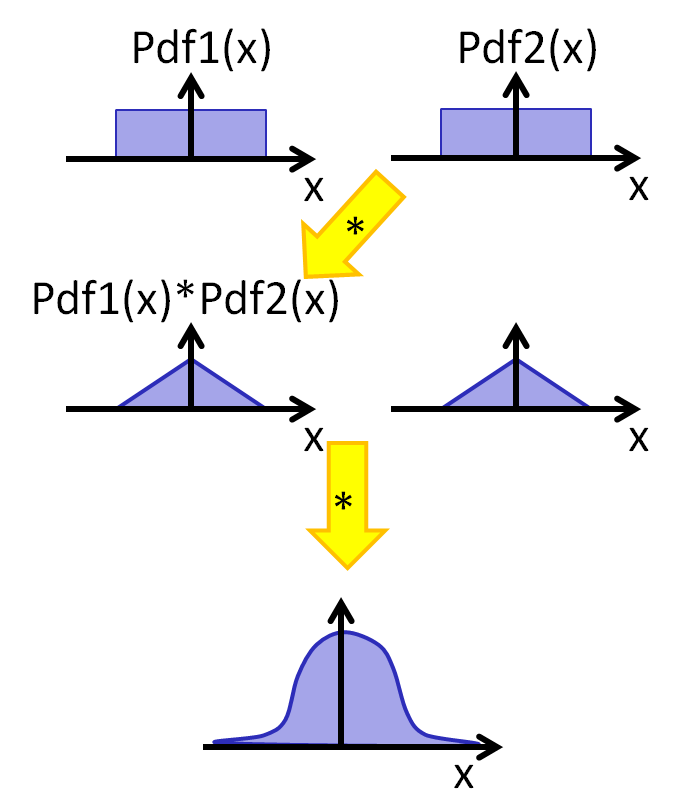
|
Gaussian distribution
|
Equation: \( p(x) = \frac{1}{\sigma \sqrt{2 \pi }} e^{- \frac{1}{2} \left( \frac{x-\mu}{\sigma} \right)^2 } \) µ expected value σ standard deviation σ2 variance This distribution has no bounds. The higher the number of components, more components are out of a certain bound. Manufacturing a resistance or capacitance will also result in variations of value. This causes INL and DNL errors for data converter and can lead to bad faulty devices. Width of two, four and six standard deviations have 68.27%, 95.45% and 99.73% of the population. |
Realization
|
In integrated circuits all elements have a gaussian distribution around the designed value. Since good data converters must meet strict requirements for INL and DNL, high variations of circuit elements can cause bad INL and DNL. What variation of circuit elements can be tolerated? How does mismatch influence INL and DNL?
Example: 0.1% resistor tolerance |
Unit element mismatch and DNL
|
Only random error: Iref: reference current Rnom: nominal resistance \( \Delta_i = I_{ref} \cdot R_i \) \( DNL_{i} = \frac{\Delta_i - \Delta}{\Delta} = \frac{ R_i - R_{nom}}{R_{nom}} \approx \frac{dR}{R_i} \) \( \sigma_{DNL} = \sigma_{R} \) 1% tolerance in resitance gives 1% = 0.01 DNL. |
|
Unit element mismatch and INL: Theory
\( \sigma_{INL}^2 = (1 - r)^2 \cdot \sigma_{A}^2 + r^2 \sigma_{B}^2 \)
\( \sigma_{INL}^2 = (1 - r)^2 \cdot x \cdot \sigma_{\epsilon}^2 + r^2 \cdot (N-x) \cdot \sigma_{\epsilon}^2 \)
\( \sigma_{INL}^2 = x \cdot \left( 1 - \frac{x}{N} \right) \cdot \sigma_{\epsilon}^2 \)\( \sigma_{INL}^2 = (x - 2 \cdot x \cdot r + x \cdot r^2 + r^2 \cdot N - x \cdot r^2) \cdot \sigma_{\epsilon}^2 \) \( \sigma_{INL}^2 = (x - 2 \cdot \frac{x^2}{N} + \frac{x^2}{N} ) \cdot \sigma_{\epsilon}^2 \) \( \sigma_{INL}^2 = (x - 2 \cdot \frac{x^2}{N} + \frac{x^2}{N} ) \cdot \sigma_{\epsilon}^2 \) |
|
Unit element mismatch and INL
|
Only random error: \( \sigma_{INL}^2(x) = x (1 - \frac{x}{N}) \cdot \sigma_{\epsilon}^2 \) \( \sigma_{INL}(x) = \sqrt{x (1 - \frac{x}{N})} \cdot \sigma_{\epsilon} \) Maximum: \( \frac{\sigma_{INL}^2}{dx} = 0 \) \( 1 - \frac{2 x}{N} = 0 \) \( x = \frac{N}{2} \) \( \sigma_{INLmax} = \sqrt{\frac{N}{2} (1 - \frac{N}{2 \cdot N})} \cdot \sigma_{\epsilon} \) \( \sigma_{INLmax} = \frac{1}{2} \sqrt{ N } \cdot \sigma_{\epsilon} = \frac{1}{2} \sqrt{ 2^{B} -1 } \cdot \sigma_{\epsilon} \) |
Example: N = 63 |
|
1% variance in resitance gives with:
6 bits: N = 63; σINL = 4 · 1% = 4% = 0.04
10 bits: N = 1024; σINL = 32 · 1% = 0.32
14 bits: N = 16384; σINL = 128 · 1% = 1.28
Binary weighted DAC DNL and INL
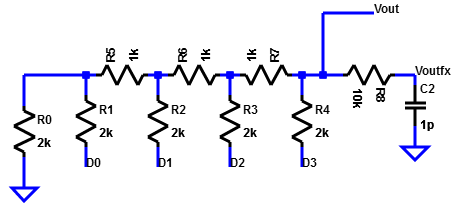 INL same as unit element INL. \( \sigma_{INLmax} = \frac{1}{2} \sqrt{ 2^{B} -1 } \cdot \sigma_{\epsilon} \approx \frac{1}{2} \cdot 2^{\frac{B}{2}} \cdot \sigma_{\epsilon}\) Switching in the center: Half devices on, half minus one devices off DNL: Switching at center position: 011111..100000 \( \sigma_{DNLmax}^2 = \left( 2^{B-1} - 1 \right) \cdot \sigma_{\epsilon}^2 + \left( 2^{B-1} \right) \cdot \sigma_{\epsilon}^2 \) \( \sigma_{DNLmax} \approx 2^{\frac{B}{2}} \cdot \sigma_{\epsilon} = 2 \sigma_{INLmax} \) |
Comparison INL and DNL: Binary weighted versus unit elements
Binary weighted topologyR2R:\( \sigma_{INLmax} \approx \frac{1}{2} \cdot 2^{\frac{B}{2}} \cdot \sigma_{\epsilon}\) DNL: \( \sigma_{DNLmax} \approx 2^{\frac{B}{2}} \cdot \sigma_{\epsilon} \) \( \sigma_{DNLmax} \approx 2 \sigma_{INLmax} \) B, 2B, 3B elements |
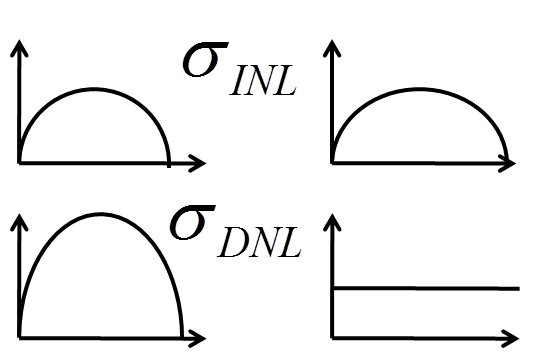 |
Unit element topologyR-string:\( \sigma_{INLmax} \approx \frac{1}{2} \cdot 2^{\frac{B}{2}} \cdot \sigma_{\epsilon}\) DNL: \( \sigma_{DNLmax} = \sigma_{\epsilon} \) 2B elements |
Motivation of segmented DAC with MSB unit elements and LSB with binary weights.
Publication: Simulation of INL and DNL
Javascript Simulation DAC Error
C. Lin and K. Bult, "A 10-b,500-MSample/sCMOS DAC in 0.6mm2," IEEEJournal ofSolid-StateCircuits, vol.33, pp. 948- 1958,December1998.
Simulation of 100 runs of unit and binary 10 bit DAC with random variations with a σεof 2 %.
Plots of INL and DNL showed expected shape of distribution.
RMS of simulation showed the expected values for INL and DNL.
Motivation of segmented DAC with MSB unit elements and LSB with binary weights.
A LTSPICE simulation example with a 3-bit unit element DAC and a 3 and 4-bit binary DAC can be done to look at DNL and INL error.
Realization of resistors and capacitances
Process variables:
|
Undercutting Non uniformities Unit elements Ratio area to edge is constant. Common centroid design Systematic vertical and horizontal variations cancel out. Dummy elements |
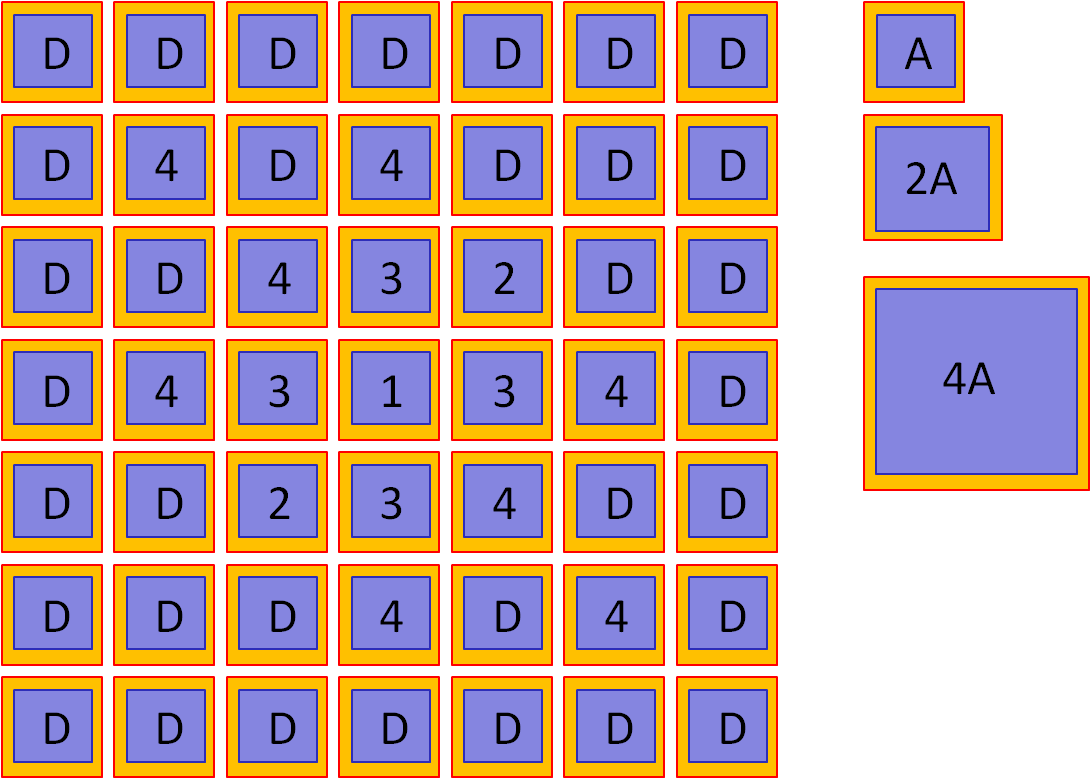 Capacitances |
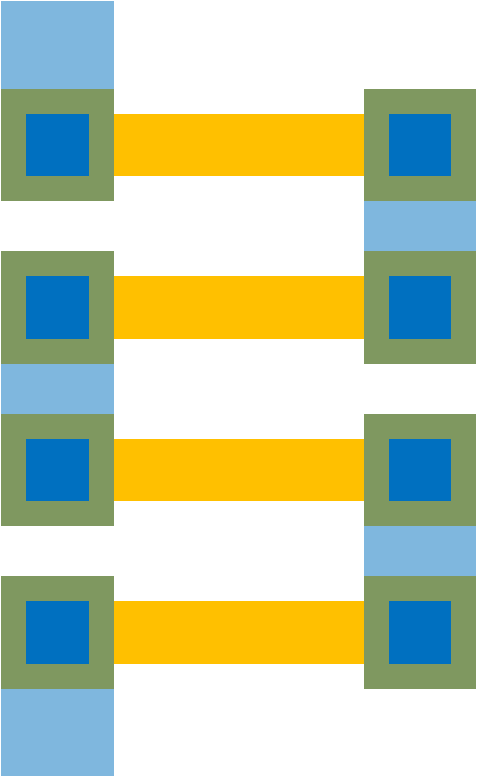 Resistors |
Test and Calibration
Calibration
- Element trimming (laser fuse) at the end of wafer fabrication
- Inverse equation
- Lookup table
- Online background calibration
Test and strategy for calibration
- Identify topology: unit or binary weighted
- Unit elements
- Binary weighted elements
- Start in the center with biggest error
Laboratory and Calibration
How much can digital calibration do for a binary weighted DAC?
- Measure DNL and INL
- For big steps in output voltage, DNL large, change capacitances.
Jump at step 64, change capacitances at input D5 with a capacitance between D4 and D5. - Negative steps or negative DNL create an equation
if (code && 128) { code = code + x } - Create new calibrated input code ramp and measure INL and DNL again.
- Create new calibrated input code for sine input signal and measure FFT, INL and DNL again.
DAC digital calibration example
 |
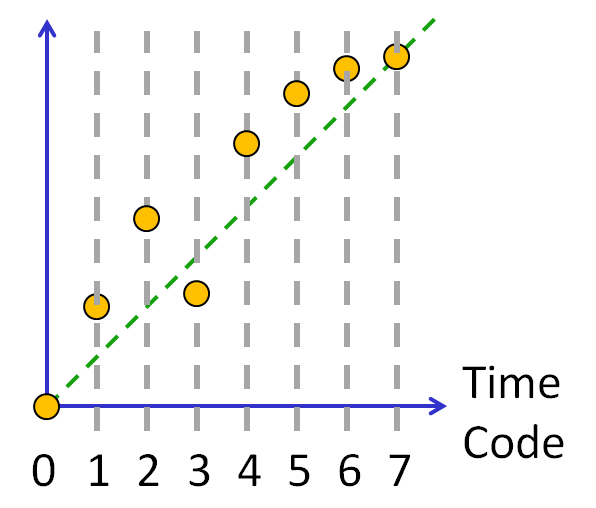 |
DAC digital calibration example result
Lookup table, equation
 |
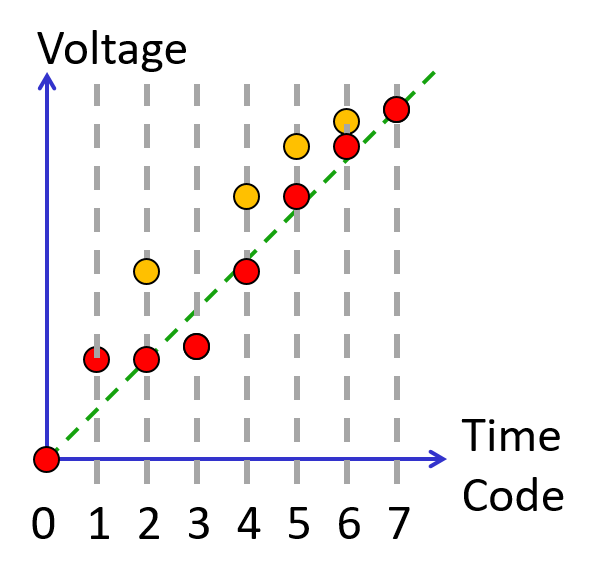 |
Some codes are very much off the ideal transfer curve (green dotted line).
There is a lookup table placed between the external signal and the internal DAC signal.
For the external Code an internal codeX is generated.
The maximum INL, DNL error of +-2.2 is then reduced to +0.5..-1.
This is still not good enough (below 0.5).
There is a lookup table placed between the external signal and the internal DAC signal.
For the external Code an internal codeX is generated.
The maximum INL, DNL error of +-2.2 is then reduced to +0.5..-1.
This is still not good enough (below 0.5).
DAC digital calibration example result
Lookup table, equation
|
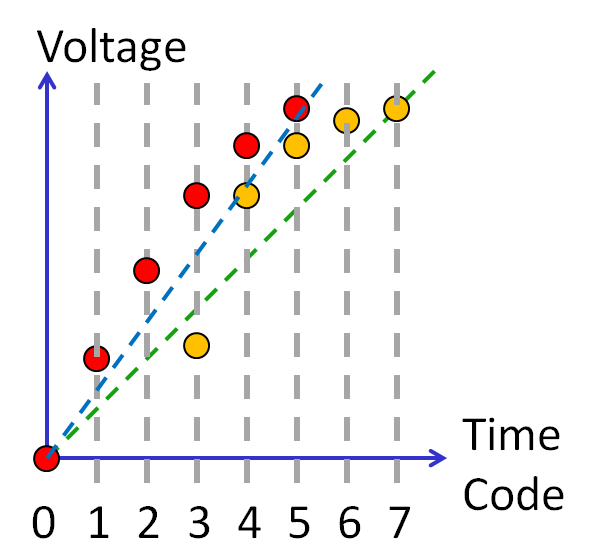 |
The number of used codes (Codex) are now reduced to 5 and mapped to internal 7 codes (Code).
Again INL and DNL is improved.
The maximum INL, DNL error is reduced to +0.57..-0.29.
This is still not good enough (below 0.5).
The maximum INL, DNL error is reduced to +0.57..-0.29.
This is still not good enough (below 0.5).
DAC digital calibration: 1 bit reduction
Lookup table, equation
|
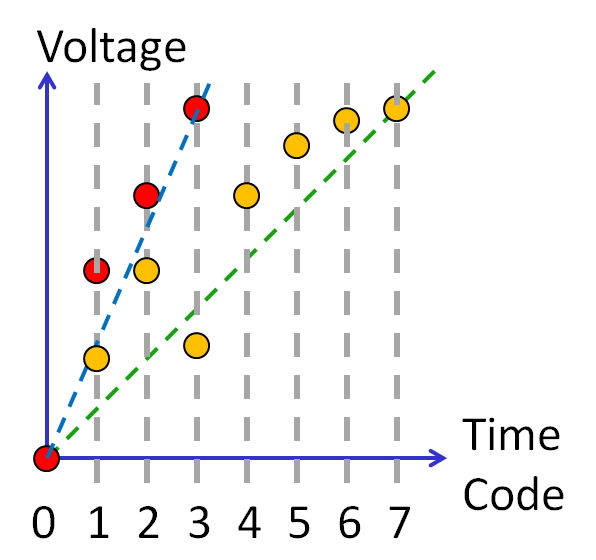 |
DAC digital calibration: 1 bit reduction
Lookup table, equation
|
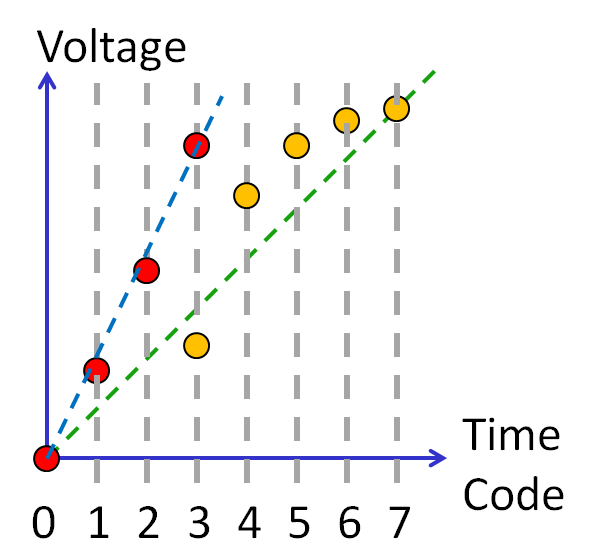 |
DAC digital calibration summary
Digital calibration is possible.
Lookup table, equation
INL should be in the range of ± 1/2 LSB.
DNL should be in the range of ± 1/2 LSB( ± 1 LSB).
For a power of 2 DAC half the step size, until INL and DNL are smaller than 1/2 LSB.
Otherwise sort the values and identify the biggest step size stepmax.
Depending on the other DNL values the real step size can be between 1.5 LSB = 1.5 stepmax and LSB = stepmax.
Since numbers are displayed in decimal some codes could be omitted for having a nice decimal step size: 10 mV, 5mV, 2 mV or a good range.
Binary decimal conversion:
1024 .. 1000
4096...4000
65536..50000
References
[1] "Nonlinearity analysis of resistor string A/D converters" S. Kuboki; K. Kato; N. Miyakawa; K. Matsubara IEEE Transactions on Circuits and Systems Year: 1982, Volume: 29, Issue: 6 Pages: 383 - 390
[2] "A 10-b,500-MSample/sCMOS DAC in 0.6mm2," C. Lin and K. Bult, IEEEJournal of Solid-State Circuits, Year: 1998, vol.33, December, pp. 948- 1958
